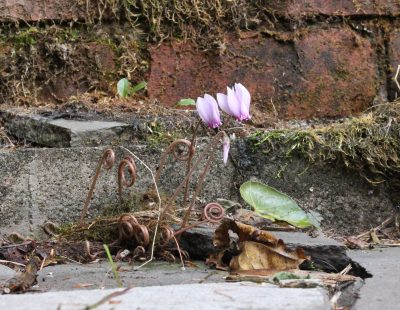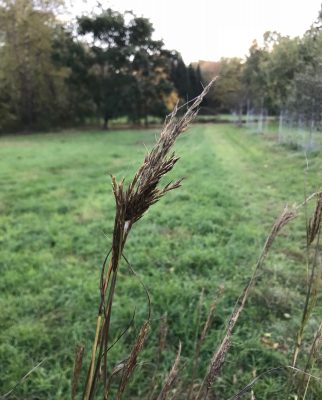Mo’ Plants
Cyclamen Addict
I’ll admit to being an addict. But my addiction — to propagating plants — is benign. It pains me to throw away an interesting seed or pruned-off stem; either can grow into a whole new plant, anything from a charming little flower to a towering tree.

Hardy cyclamen self-sown seedling

Hardy cyclamen in pot
Case in point are some cyclamen seeds I collected and sowed a couple of years ago. The mother plant is Cyclamen hederifolium, a species that differs from the large, potted cyclamens you now see offered in garden centers, hardware stores, even supermarkets. Cyclamen hederifolium is cold-hardy here, so comes back year after years planted outdoors in the ground, and it’s a dainty plant, with small flowers and commensurately small leaves. Otherwise it looks just about the same as the widely sold commercial species, the pink or white flowers hovering like butterflies on thin stalks above the whorls of variegated leaves.
Following those flowers are seed capsules, mostly hollow balls the size of small marbles each attached to the plant by a stem that is wound up like a spring. It was in the beginning of the growing season 2 years ago that I sowed the seeds in a seed tray filled with sterilized potting mix. (I don’t usually sterilize my potting mixes but I didn’t want weeds to interfere with the slow-germinating seeds.) Eventually the seeds sprouted and I kept them watered, as needed, for good, albeit slow, growth.
Hardy cyclamen’s flowers fade and leaves melt into the ground as plants ease into dormancy with the approach of winter. Not my seedlings, though. I learned, years ago, not to push them into dormancy; instead, keep them growing as long as they want to until they’re ready to start storing energy. Which I did, with plenty of light and, as before, water as needed.
This summer, the plants were still growing — and still small — and I noticed some swelling beneath each plant.  The youngsters finally were growing tubers, small bulb-like structures that will, in the future, store energy to carry the plants, dormant and leafless, through winter.
The youngsters finally were growing tubers, small bulb-like structures that will, in the future, store energy to carry the plants, dormant and leafless, through winter.
This time next year I expect my plants will be officially adult, with flowers as testimony to their maturity.
Little House Not on the Prairie
In her youth, my daughter periodically entered the world of Laura Ingalls Wilder, so the one acre, adjoining field we acquired became “the prairie.” Moving the playhouse I built out to the field would have completed the picture of “little house on the prairie.” The playhouse never got out there but the “prairie” — or “hayfield” — as I usually refer to it, has remained as such.
My affection for prairies came from my living 12 years in Wisconsin (and studying the rich soils — the richest in the world — underlying prairies). My daughter has long outgrown her prairie phase but I’m going to make my “prairie” more prairie-like. One plant for that purpose would be big bluestem (Andropogon gerardii), the star of the Big Four of grasses native to the tall grass prairies, the other three bering indiangrass (Sorghastrum nutans), switchgrass (Panicum virgatum), and little bluestem (Schizachyrium scoparium). Big bluestem is the tallest of the lot towering 6 to 10 feet high. It’s also good for hay and wildlife, and tolerates drought.
A few years ago I bought some big bluestem seeds and ended up with just a few plants. Those plants are now producing seed which — I can’t help myself — I’ve collected.  Not that some of the seeds wouldn’t self-sow near the mother plans, but seedlings that do sprout under natural conditions are subject to competition for light, nutrients, and water from other plants.
Not that some of the seeds wouldn’t self-sow near the mother plans, but seedlings that do sprout under natural conditions are subject to competition for light, nutrients, and water from other plants.
Like many fall-ripening seeds, big bluestem seeds won’t sprout as soon as they hit the ground; otherwise winter cold would do them in. So they need “stratification:” a false (or real) winter. For many seeds, cool, moist conditions, such as a few weeks residence in a mix of moist peat and perlite in a plastic bag in the refrigerator will do the trick. Big bluestem can also be coaxed out of its winter slumber with cool, dry conditions. Perhaps I’ll try both ways.
Bluestem Addiction
My present tallgrass prairie is only about 4 square feet, from two seedlings I originally planted plus their slow underground spread with rhizomes. Over time, with my additional plantings and help — a once a year, late winter mowing (taken care of under natural conditions with fire) — my prairie will swell.
A prairie takes time, as does, though less is needed, raising cyclamen to flower from seed. That time element itself brings with it certain satisfactions, both with the process and the result. That’s fortunate, since patience is an important element in successful propagation of plants.


Hi, and thanks for this interesting post. If I understand correctly, your cold-hardy cyclamen are still in a container and maybe not spending the winter out of doors? If so, at what point do you think they will be ready to go in the ground?
Best wishes.
I think my cyclamens could go into the ground as soon as they go dormant.
How wonderful! I love Big Bluestem, Indian Grass, Switch Grasses … could it be because I was born in WI? Hmmm. I admire your patience in beginning a prairie of these beautiful grasses. I suspect many people plan a “meadow” that goes by the wayside. Now that I’m in the woods up North, I find I like not having a landscaped garden. I admire the natural beauty. I have to revisit cyclamen! As a girl, I loved that flower. I need to research a variety that may grow in zone 9 now that I have a warm winter home. For now, I am going to test my patience with Magnolia seeds – 15 years to bloom time!
In Zone9 I imagine that you could grow the standard florists’ cyclamens outdoors.
I live in Wisconsin and I am wondering about giving part of my yard over to prairie plants. Is that possible in a small area of maybe 20×30ft? I am in a pocket of zone 5a in sw WI. If so, how would you recommend going about that endeavor in a yard that is mostly cultivated lawn grasses?
There’s a few ways, depending on your resources and energy.
1.Cover the area with landscape paper or 4 sheets of newspaper, wetted in either case. Top that with 1″ or more of weed free compost, and plant.
2. Strip the sod, top bare ground with some compost, and plant.
3. Plant “plugs” of desired plants right into lawn and hope they spread to out-compete the lawngrass.
4. Till up the whole area (shallowly), top with some compost, and plant.
I go into much more detail in a whole section of my book WEEDLESS GARDENING.
Thank you. I had recently purchased that book and your newest one as well. Since my husband started with “Weedless Gardening” I started with the other! Will switch to “Weedless Gardening” after the holidays as I only brought “The Ever Curious Gardener” with me on this trip and he’s reading that now!
Thank you. I had recently purchased that book and your newest one as well. Since my husband started with “Weedless Gardening” I started with the other! Will switch to “Weedless Gardening” after the holidays as I only brought “The Ever Curious Gardener” with me on this trip and he’s reading that now!